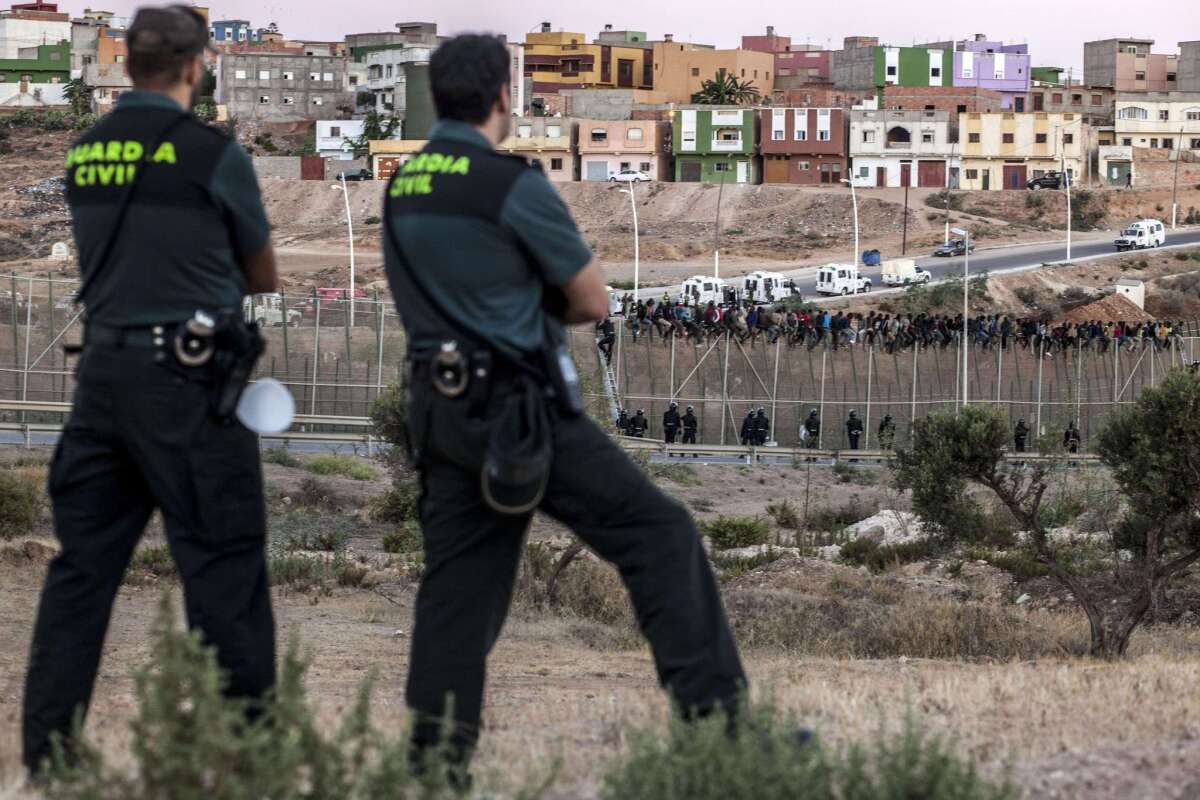Op-Ed: Why trying to ‘secure’ a border is futile

- Share via
Can borders stop immigrants?
The particular border I have in mind looks like an obstacle course for mythical giants. To pass it, you would have to cross a 12-foot-wide ditch, climb a wall topped with blades, then scale three metal fences, two of them 20 feet high. You would need to elude surveillance cameras and motion-activated alarms, not to mention a multitude of well-equipped guards.
On paper at least, the border surrounding the city of Melilla seem unassailable. Like Ceuta, 200 miles west, Melilla is an anomaly: It is politically a part of Spain, but it is in Morocco, a holdover from medieval Spanish incursions along the African coast. Its border is meant to stem the flow of immigrants from south to north.
Yet on Aug. 12, several hundred immigrants managed to scale the border fences in the middle of the night. Most of them were immediately repelled. A few made it through. But some of them were caught on a metal fence, a place of physical ambiguity and legal uncertainty. On one side, Europe. On the other, Africa.
These men had likely walked thousands of miles from their home countries. They had braved the heat of the Sahara, survived encounters with various police forces and camped for weeks or even months on nearby Gourougou Mountain before attempting to cross the border. Never before had they been closer to their goal.
All day long, these men sat on the fence, under the heat of the summer sun, hoping for a miracle — entry into Europe and designation as asylum-seekers. What were their names? What cities or villages did they call home? Where were they planning to go? The news reports did not say.
Thirty years ago, the Melilla border was different. One summer in 1975, my parents announced that we were going on vacation. They packed my siblings and me in our old red Renault and we drove from our home in Rabat, the Moroccan capital, up the Atlantic coast. Over the next week, we swam in Asilah, walked the hilly streets of Tangier and got lost in the crooked alleyways of Tetuan. When we arrived in Melilla, on the Mediterranean Sea, it suddenly dawned on my parents that my baby brother, who was only 6 months old, had not been added to either of their passports.
“Should we turn back?” my mother asked.
“And lose the whole day?” my father said. “No, let’s just give it a try.”
The Spanish border post was a tiny, cinder-block building. The guard checked our passports, then asked about my brother. My father explained he hadn’t gotten around to adding the baby. “But we’re only staying the day,” he said.
So the guard waved us through. We walked the city’s main thoroughfare and ate scrumptious bocadillos in the park. I remember standing up on a bench and looking across the Mediterranean. In the hazy distance was Spain. We returned to Tetuan, in time for dinner.
Growing up in Morocco, Spain was always on the periphery of my consciousness. When the weather was clear, our antenna could receive a signal from Spanish television stations. The sounds of the language were familiar to me long before I learned to speak it. Even the enclave of Melilla had not struck me as being all that different from a Moroccan city.
But as the years went by, the disparities between the two countries grew wider. Spain slowly transitioned from dictatorship to democracy, while Morocco stagnated in “democratization,” a process of never-ending reforms that firmly maintains power in the hands of the king. Spain joined the European Union and grew its economy; Morocco mired itself in debt and debt-restructuring programs.
Little wonder then that, by the late 1980s, the number of Moroccans hoping to immigrate to Spain had swelled. Over the last two decades, however, there has been a shift. Immigrants now come from many parts of Africa — Cameroon, Mali, Nigeria — to the north of Morocco. Once there, they try to cross the Mediterranean Sea on rafts or makeshift boats, which often capsize. Thousands of immigrants have perished in this way. This helps explains why so many people now turn to the land route, and to the fences in Ceuta and Melilla.
Both Spain and Morocco have continually imposed tighter controls over their land and sea borders. But the more stringent the restrictions, the more resourceful the immigrants. When higher fences were erected, immigrants used ladders. When more guards were posted, immigrants came up with a new tactic: scale the fence en masse. This summer, the Spanish government installed anti-climb mesh on the fence. Determined immigrants foiled it by attaching hooks and screws to their shoes.
The continual renovations to the Melilla border are a lesson on the futility of “securing” the border. The focus of the debate, always, seems to be: How can immigrants be stopped at the gates? Perhaps the more useful question is why do people leave their homes in the first place? The reasons may be unemployment, poverty, war, an autocratic political system, an optimistic view of the life that awaits on the other side. Until those issues are addressed, people will not be discouraged from trying to improve their lives.
The immigrants who were stuck on the fence in Melilla on Aug. 12 sat there all day, waiting. And then, one by one, they came down and were deported to Morocco.
A day later, there were fresh reports of another mass crossing.
Laila Lalami’s new novel, “The Moor’s Account,” was published this week.
Follow the Opinion section on Twitter @latimesopinion
More to Read
A cure for the common opinion
Get thought-provoking perspectives with our weekly newsletter.
You may occasionally receive promotional content from the Los Angeles Times.











